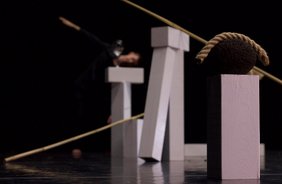Benjamin Richter Contemporary Circus Art
TLO - The Language of Objects
In a research laboratory in 2008, Benjamin first named the term The Language of Objects.
The word language ascribed an agency to objects that had not been named before in the circus world. This less hierarchical approach to working with objects has since been adopted by countless other contemporary circus makers. The TLO method itself was named and its development has continued ever since.
TLO is a structured checklist of questions and impulses designed to sensitise humans to the presences, agencies and affordances of objects. Initially a personal creation method, it encompasses many aspects of Benjamin's choreographic and performance philosophy, that has been developed over more than 30 years. TLO enables others to not only develop their own object-oriented sensitivity, but to understand more about their own creative processes.
According to object-oriented ontology (OOO), objects exist in their own right and with their own agency, regardless of whether humans are present or not. In OOO the word Object, can also be used to define any kind of physical or non-physical phenomena. A thought, an emotion, a choreography, a summer breeze, a group of buildings or humans: all of these things can be encountered as objects. Expanding on William Forsythe's definition of choreography as being the organisation of bodies in time and space, Benjamin's method includes all kinds of objects, human and non-human, into his practice of organising bodies and objects in time and space.
As well as using the method in his own creations, Benjamin has taught TLO to BA, MA and PHD students at the Stockholm University of the Arts, as well as at other performing arts universities and institutions and in independent workshops all over Europe.
Benjamin has applied and shared TLO in his work accompanying other artists whose projects he has accompanied, including Andrea Salustri, Kolja Huneck, Marie-Andree Robitalle, Below Zero Company, OLO Company, Roman Skadra, Karla Aravelu, Stefan Sing, Luuk Braantjes, Emma Laule, Hippana-Maleta and many others.
TLO has left a strong trace in the circus world, with it now being commonplace for artists to regard their objects as more equal partners and to give space to their inherent values, meanings and presences. Benjamin sees this to be a valuable development towards a more sustainable relationship with objects and materials in the performing arts and the world in general.


